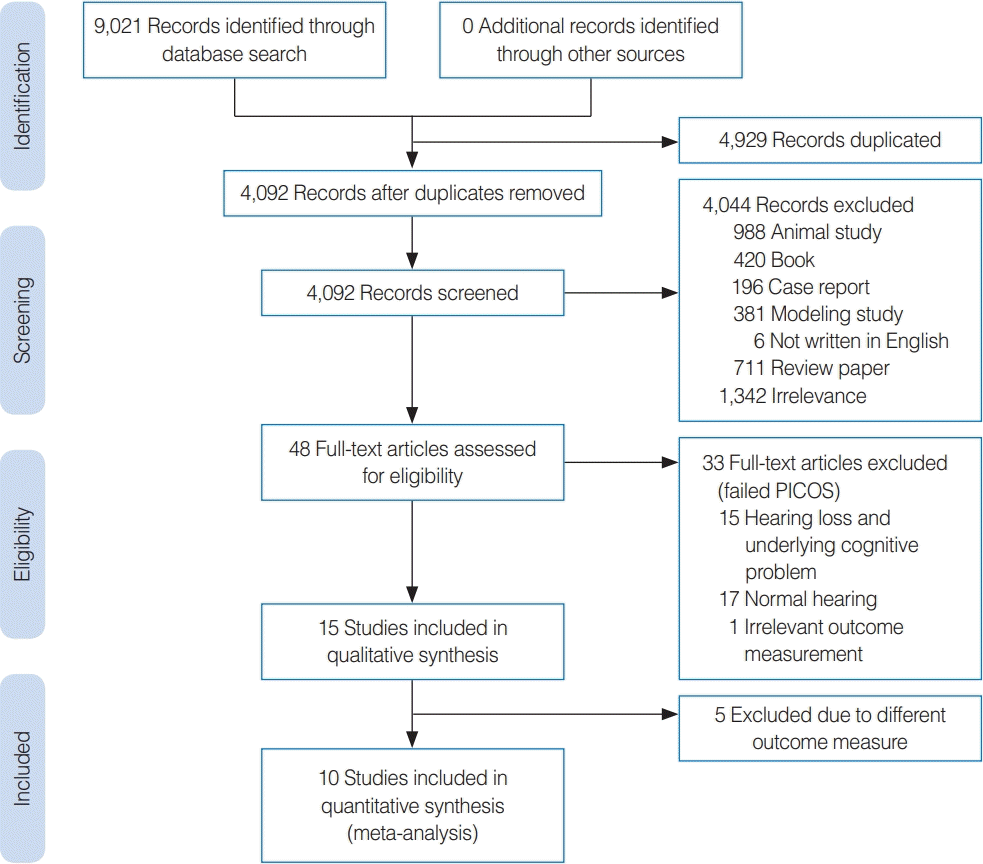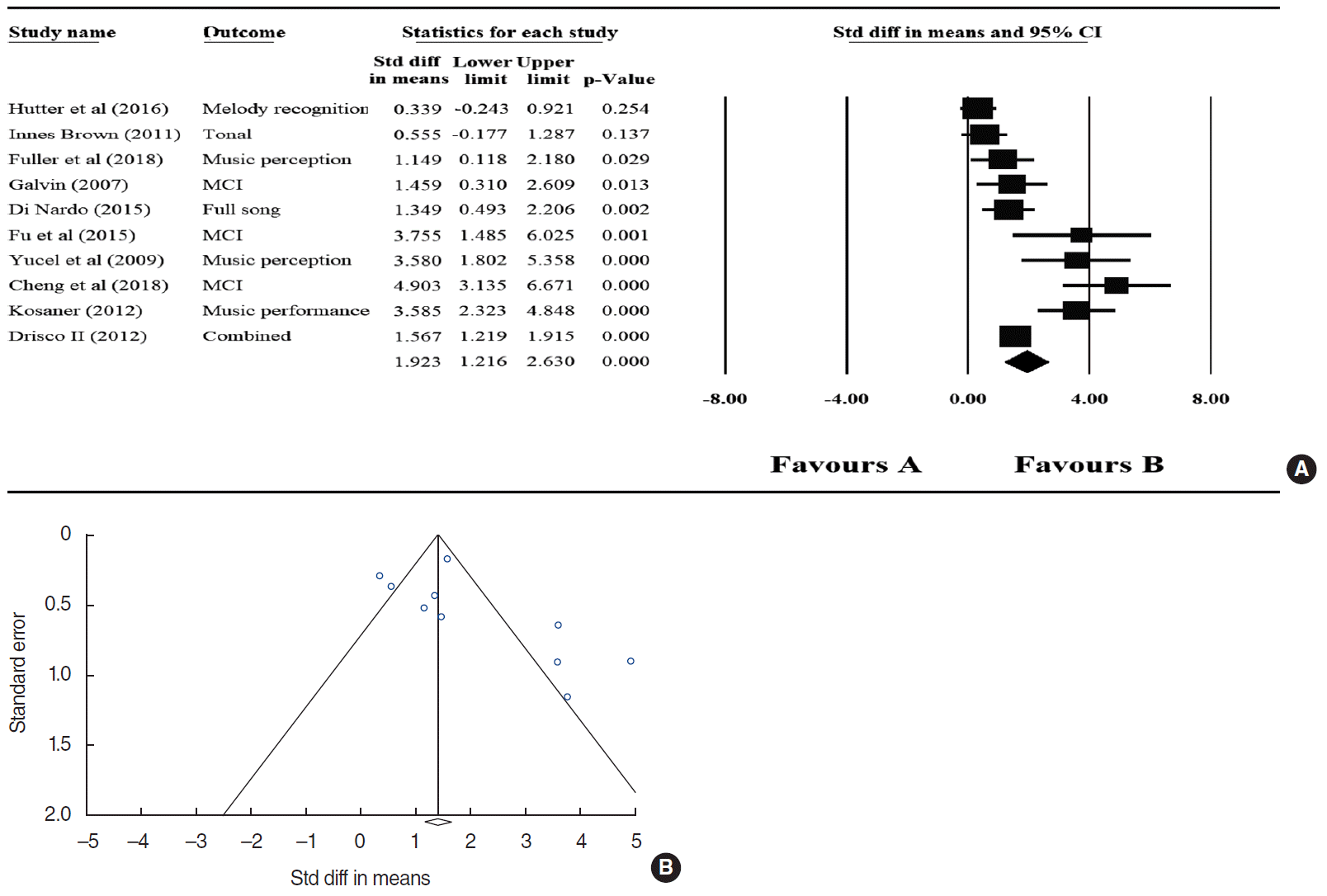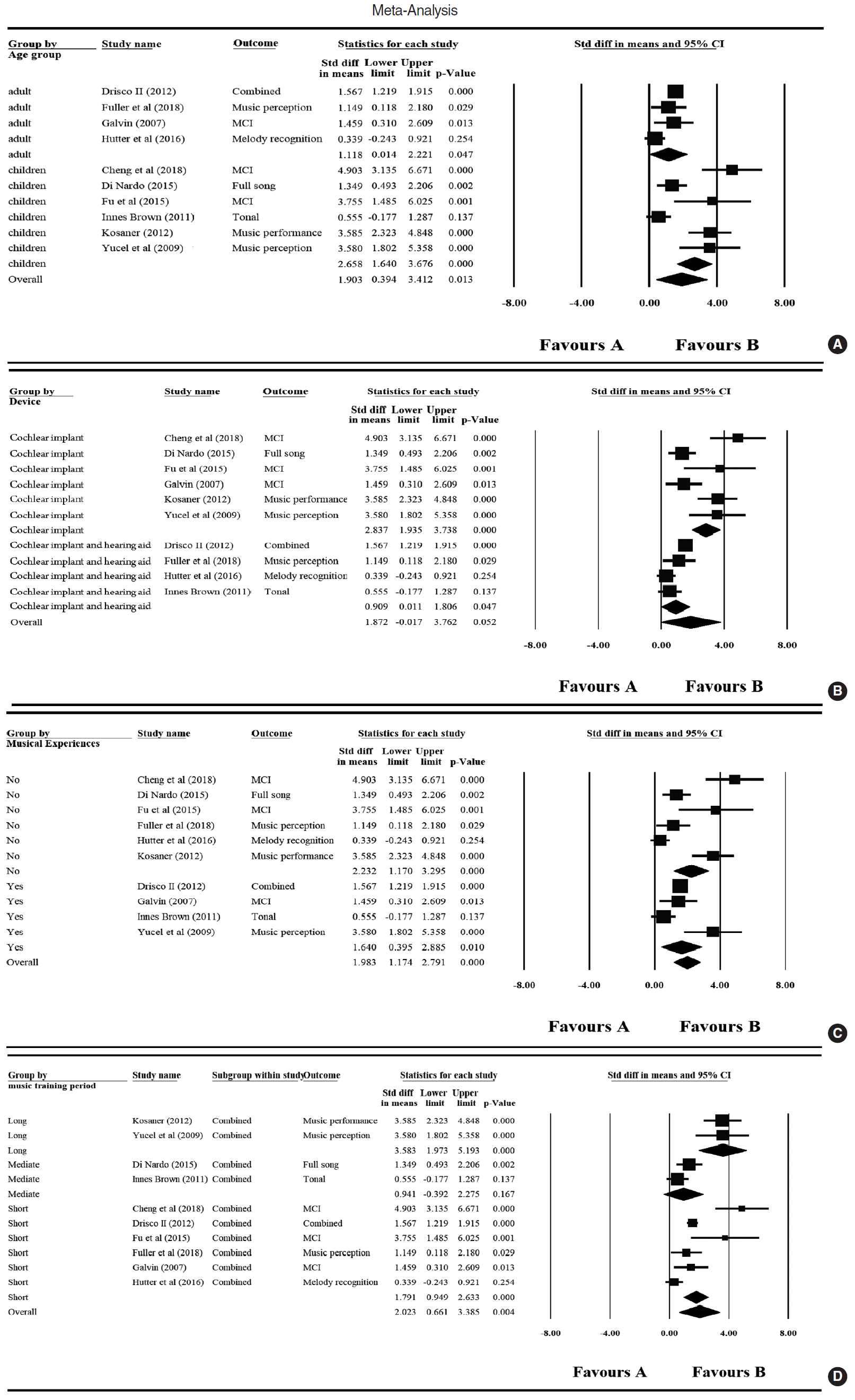|
Yucel et al. (2009) [23] |
Randomized controlled trial |
Profoundly hearing-impaired children |
n=18 (music group: 9) |
Normal hearing children: n=9 |
An electronic keyboard (YAMAHA PSR-295) |
10 min/day every day for 2 years |
Home training |
Improvement of musical perception (pitch, rhythm, and melody) |
Music group: |
|
Age: not specified |
Ling’s six-sound detection (P<0.05) |
|
Unilaterally implanted with cochlear implants; HiRes stimulation mode |
Age at implantation: 39–96 months |
Listening to two pairs of notes |
Evaluation after 1, 3, 6, 12, and 24 months (24 months) |
Word identification (P<0.05) |
|
Age: not specified |
Based on note discrimination |
Daily sentences (P>0.05) (not significant) |
|
Sex: NA |
Music stage questionnaire (P<0.05) |
|
Di Nardo et al. (2015) [21] |
Experimental study (repeated measure) |
Bilateral hearing loss |
n=10 (6 boys, 4 girls) |
None |
Auditory music training program (home-learning program) |
6-Month training period |
Home training |
Improvement in musical perception (frequency discrimination, pitch recognition, and appraisal) |
Musical pitch discrimination test showed a significant improvement in musical perception after music training (P=0.001) |
|
Mono-aural nucleus CI users |
Age: 5–12 years |
Frequency bands: 262–523 Hz, 523–1,046 Hz, and 1,046–1,976 Hz (used for most of the song, 36 notes) |
At least 2 hours weekly (6 months) |
|
Hearing age with CI, ±26 months |
Music test result (pre-and post-training: P=0.015) (melodic version: P=0.007) |
|
Fu et al. (2015) [22] |
Repeated measures |
Children with congenital hearing loss |
n=14 (boys: 7 girls: 7) |
None |
Five tones, three tones, five piano stimuli (different root notes used for training) |
Half-hour per day |
Home training |
MCI |
Mean performance improved for all outcome measures |
|
Mandarin-speaking |
Age: 5.5–9.7 years (mean, 7.8 years) |
23 Root notes (250 ms with 50 ms of silence between each note) |
Every day for 10 weeks 2.5 months |
Tone recognition and speech perception |
Five tones (mean improvement, 57.3 points; SE, 11.1) |
|
Had at least 2 years of experience with CI |
Mean CI usage: 4.9 years (2.3–7.7 years) |
All stimuli presented at 70 dBA |
Three tones (mean improvement, 45.8 points; SE, 10.9) |
|
Five piano stimuli (mean improvement, 45.8 points; SE, 8.2) |
|
Cheng et al. (2018) [25] |
Non-randomized controlled trial |
Mandarin-speaking CI children |
CI group: n=16 (5 girls, 11 boys) |
Normal group n=22 (11 girls, 11 boys) |
(1) MCI stimuli: nine melodic contours (rising, rising-flat, rising-falling, flat-rising, flat, flat-falling, falling-rising, falling-flat, falling) Five notes of equal duration (250 ms, 50 ms of silence between notes) |
15 min/session |
Rehabilitation center |
Music (MCI and tone recognition) and speech perception (sentence recognition) |
Significant effect recorded for |
|
Prelingually deaf and diagnosed with severe-profound SNHL before 1 year old |
Age: 1.7–6.1 years; mean, 6.3 years |
Age: 4.5–9.3 years; mean, 6.2 years |
Three sessions per training day |
(1) MCI mean improvement: 22.0 (range, 5.7–47.2) |
|
CI experience: 0.8–6.0 years; mean, 2.8 years |
(2) Lexical tone stimuli: 64 stimuli (4 tones×4 monosyllables×4 talkers) |
5 day/wk for 8 weeks 2 months |
(2) Tone recognition: 14.5 (range, 4.7–32.8) |
|
(3) Sentence recognition: 14.5 (range, 1.5–34.3) |
|
Fuller et al. (2018) [16] |
Randomized controlled trial |
Dutch-speaking adults who were CI users |
(1) Pitch/timbre group (n=6); age: 56–73 years; CI experience: 5–11 years |
Control (non-music training), n=4 |
(1) Pitch and timbre: |
2 hr/session (15-minute break) |
Rehabilitation center |
(1) Word identification |
(1) Word identification: |
|
Used CI more than 1 year |
Age: 66–80 years |
MCI (five training sessions) |
Weekly session for 6 weeks 1.5 months |
Timbre: P<0.001 |
|
Some participants used hearing aids in the contralateral ear. |
(2) Music group (n=6); age: 59–71 years; CI experience: 3–10 years |
CI experience: 4–6 years |
MCI: one test |
(2) Sentence identification (both consisting of speech perception) |
Music: P=0.708 |
|
Instrument identification/daily sound identification |
Overall: P=0.005 (significant) |
|
MCI (five training sessions) |
(2) Sentence identification: |
|
MCI (one test) |
Timbre: P=0.339 |
|
(2) Music therapy |
Music: P=0.328 |
|
Listening to music and emotional speech |
Overall: P<0.05 (significant) |
|
Listening to musical speech |
|
Singing |
|
Playing an instrument |
|
Improvising music |
|
Session questionnaire |
|
Driscoll (2012) [17] |
Randomized controlled trial |
Post-lingual deaf adults aged >18 |
n=71 (21 men, 50 women) |
n=24, feedback on correct musical cues |
Recording of solo performance of eight musical instruments: |
15 Sessions |
Home training |
Improved recognition of musical instruments |
(1) Musical background questionnaire recognition test: Week 3: significant difference observed (P<0.001) |
|
Read/understand written English |
Age: 26–88 years (mean, 62.59 years) |
(1) Representing a range of low, middle, and high frequencies |
10 min/session |
(2) Significant improvement observed from week 3 to week 5 (P=0.011) |
|
Have access to a computer with internet and sound capabilities |
Bilateral: 21, unilateral: 50 |
(2) Five melodies from each instrument |
Three times/wk over 5 weeks 1.2 months |
No significant improvement in timbre recognition |
(3) Individuals with bilateral CI scored significantly higher than those with unilateral CI (P=0.02) |
|
Used CI, HA, or both |
Divided into three groups |
|
Galvin et al. (2007) [18] |
Non-randomized controlled trial |
Adults with no musical experience |
n=6 (4 men, 2 women) |
n=9 |
Melodic contour identification training (nine five-note melodic patterns) |
4 subjects: 30 min/day; everyday (1 to 2 months) |
Home training Rehabilitation center |
Improvement in: |
MCI performance (percent correct): 15.5%–45.4% improvement FMI performance: with rhythm cues: 9.1% improvement (P=0.373, not significant) Without rhythm cues: 20.8% improvement (P=0.020, significant) |
|
CI users |
Wearing CI |
Normal hearing |
Two subjects: 3 hours per day, 1 week 2 months |
MCI performance (vowel recognition) |
|
Age: 26–75 years |
FMI test (music perception performance) |
|
Hutter et al. (2015) [19] |
Experimental study (repeated measures) |
Adults >18 years |
n=12 (6 women, 6 men) |
No control group |
Five modules of music therapy: |
10 Individualized sessions |
Rehabilitation center |
Hearing performance in musical parameters |
(1) Pitch discrimination: P=0.027 (no significant difference) |
|
Post-lingual deafness, |
Age: mean, 54 years |
(1) Variability of voice and speech |
50 min/session |
(1) Pitch discrimination |
(2) Melody recognition: P<0.018 (significant) |
|
Unilaterally implanted CI users |
(2) Diverse components of music |
(2) Melody recognition |
(3) Timbre identification: P=0.004 (significant but only in unilateral CI users) |
|
(3) Playfully used components of speech |
(3) Timbre identification |
|
(4) Speech in diverse hearing surroundings |
|
(5) Complex hearing |
|
Kosaner et al. (2012) [24] |
Experimental study (repeated measures) |
Pediatric CI |
n=25 |
No control group |
Live or recorded music Each group: a set of six songs and six rhymes |
Groups A and B participated with parents in one group session (45 minutes, one individual session of 20–30 min/wk for 18 months). |
Rehabilitation center |
Improvement in performance of the musical component |
Recognizing song, tunes, and timbre |
|
Unilaterally implanted CI users |
Divided into three groups: |
Tonal music with range pitch, timbre, intensity, and frequency |
Responding to music and rhythm |
|
Group A: n=12 (3 girls, 9 boys; mean age: 26 months) |
Music associated with animals and actions and stories related to music was created. |
Group C: one group and one individual session/wk for 3 months |
Singing |
|
Group B: n=7 (5 girls, 2 boys; mean age: 43 months) |
Overall improvement |
|
Group C: n=6 (3 girls, 3 boys; mean age: 72 months) |
Group A: P<0.001 |
|
Group B: P<0.001 |
|
Group C: P=0.027 |
|
Innes-Brown et al. (2013) [20] |
Non-randomized controlled study |
School-age children |
n=11 (4 girls, 7 boys) (CI: 6, HA: 5) |
n=9 Normal hearing (5 girls, 4 boys) |
The “music club”: musical activities based on round play |
Conducted every week, 45 min/session |
Rehabilitation center |
Auditory perception (rhythmic, tonal, and timbre perception) |
Rhythmic test: pre-post training: P<0.01 |
|
Using HA and CI |
Session were divided into vocal play, physical music, and singing games. |
Tonal test: pre-post training: P=0.04 |
|
All games targeted rhythm, tempo, pitch, and timbre. |
Timbre test: pre-post training: P=0.01 |







 PDF
PDF Citation
Citation Print
Print



 XML Download
XML Download